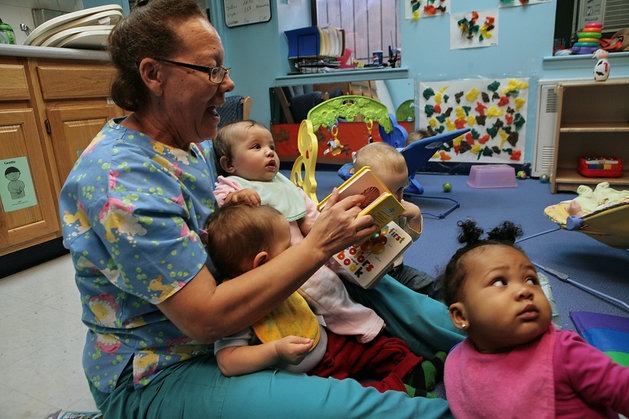The People Taking Care of Our Kids Are Some Of America’s Lowest-Paid Workers

Daniel Marans, Huffington Post
The people taking care of America’s children are some of the lowest-paid workers in the country, according to a study published Thursday by the Economic Policy Institute.
The report found that nationwide, median pay for child care workers is $10.31 per hour — 39.3 percent less than the median wage of $17 an hour earned by workers in other sectors. In fact, a look at official data shows that median child care worker pay is only slightly higher than median pay for retail salespeople, which is $10.29 an hour.
At the same time, child care is prohibitively expensive for most American families.
Given child care workers’ lower median earnings, it is not surprising that they are much more likely to be living below the federal poverty level than Americans working in other occupations.
The poverty rate among child care workers, the report notes, is 14.7 percent — more than twice the rate of 6.7 percent for other American workers.
The new study, which used Bureau of Labor Statistics numbers, follows an October report by the EPI showing that child care is as expensive as a year of public college tuition, making it unaffordable to the typical middle-class American family.
If the first report demonstrates how unaffordable American child care is, the second one shows that the exorbitant cost of care does not necessarily go toward paying the people doing the job.
Elise Gould, an author of both studies and senior economist at the EPI, makes clear that Thursday’s report seeks to raise questions about how the treatment of the workers affects the quality of the care itself.
“Despite the crucial nature of their work, child care workers’ job quality does not seem to be valued in today’s economy,” Gould writes in the report’s introduction.
Indeed there is ample evidence that child care workers’ poor pay has already had a negative impact. Most American day care providers offered care that was “fair” or “poor,” according to a 2007 government study. Only 10 percent of providers offered what the study called high-quality care.
The report also highlights how child care workers’ meager pay is especially harmful to women and people of color. Nearly all — 95.6 percent — of the 1.2 million people earning a living as child care workers are women. By contrast, women make up fewer than half of the workers in other fields.
Child care workers are also disproportionately likely to be Latino or African-American. One in five child care workers is Latino, compared with 15.7 percent of other kinds of workers. And 14.6 percent of child care workers are black, compared with 10.6 percent of workers in other occupations.
For the purposes of the study, the EPI defined child care workers as preschool teachers and professional caregivers for infants and young children. All figures are current to 2014.
The report acknowledges that child care pay is higher — and goes further — in some cities and towns than others.
But based on the EPI’s Family Budget Calculator, which accounts for geographic variation and measures a broader array of household expenses than the federal poverty level — including child care, transportation and health care costs — these people are not making enough.
Over 90 percent of non-preschool child care workers earn less than a single person needs to live in the majority of the 618 metropolitan areas examined in the EPI’s Family Budget Calculator. A single person would need an income of $26,832 a year to live in the Des Moines, Iowa, area, the median-costliest community the EPI budget calculator examined.
The slightly higher-paid preschool instructors are still unlikely to be able to afford living in many metropolitan areas.
That is especially true if they have children. In fact, ironically, these workers may have to choose between child care and other essential needs. Day care alone for infants in 32 states and the District of Columbia amounts to about one-third of a median preschool instructor’s annual pay.
In addition to lousy pay, child care workers are far less likely than their peers in other fields to receive health and retirement benefits on the job. Employer-sponsored health insurance is available to just 15 percent of child care workers, compared with 49.9 percent of workers in other professions. And employer-sponsored pension plans are available to 9.6 percent of child care workers, compared with 39 percent of workers in other professions.












